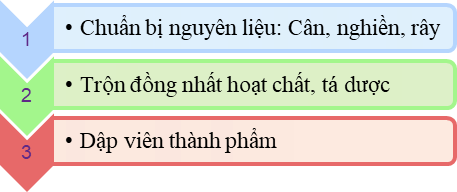Tablets are the most widely used solid dosage form and should meet a number of requirements for physical characteristics such as hardness, decay, durability and uniform mass, content. In order to meet the characteristics of the tablets in accordance with the selected components, the manufacturer can use three different compression technologies such as straight stamping (direct compression), dry grain rubbing and wetting of wet particles.
SOME POINTS ABOUT DIRECT COMPRESSION
Most of the medicinal substances need mixing with the excipients to rub seeds before the tablets. Today, in the pharmaceutical industry, there are many pre-manufactured manufacturers of multipurpose excipients and the introduction of modern stamping equipment that can help to extinguish directly, simply mix the mixture in a dry and compressed state without rubbing Particle or adjustment of physical characteristics.

The method of direct stamping was previously understood to be single-stamping. Therefore only used for substances that have a smooth and well-compressed substance such as potassium salts (chlorate, Chlorid, Bromid, Iodid, nitrate and permanganate), ammonium chlorid, ammonium bromid, sodium chlorid, sodium tetraborat, zinc sulfate, Urotropin, Pancreatin and Methenamine…
Today, direct compression is understood as the method of tablet compression without the stage of grinding seeds. Direct compression is a simple, easy to control and least expensive stamping process. The direct compression has only two main steps, dry mixing and tablet compression.
The method of wet particle rubbing has 4 additional steps: Wet mixing, particle rubbing, drying, particle repair. Not only does that require more equipment, machinery, space, manpower, costs but also the risk of cross contamination and product losses.
DIRECT COMPRESSION PROCESS

ADVANTAGES OF DIRECT COMPRESSION
- Simple process to save the cost of investing equipment, facilities and saving manpower as well as production time.
- Saving the cost of product research, appraisal of machinery, production processes and testing costs.
- Increase the consistency between the batches as the production process involves fewer steps.
- Limit cross-contamination and product losses.
- The rate of drug release is less changing over the period of preservation.
- Increase the stability of the product.
- Less damage to the substance, which is applied to both active substances that are easily destroyed by heat and moist or sensitive to solvents.
BLEMISHED CONS
- Limited application range, difficult to apply tablets with substance content too high or too low.
- Excipients have more money and must meet some technical requirements.
TECHNICAL ISSUES TO NOTE
Although there are many advantages, the direct stamping technology has not been widely applied due to technical factors such as:
- A straight-stamping substance can be a large crystalline crystalliform (Vitamin C, NaCl, KMnO4), a certain form (aspirin) or pre-granular rubbing.
- The particle size of 100-600 μm will give the tablet a good hardness.
- The right strain of the drug requires smooth flow, compressive properties, and good adhesive properties. When the pharmaceutical itself cannot be directly stamping, more excipients are needed to implant or improve the adhesion, decay, smooth discharge, compressive properties of the powder block (pharmacologically and excipients).
- Finely ground pharmaceuticals make mixing easier, ensuring that the substance is evenly distributed in the powder block at a dry mixing stage (especially with low-level tablets) and accelerates the solubility as well as the bioavailability of the drug.
- Excipients used in the method of pressing must be a multi-functional excipients, at least must include the main function is padded, sticky, half-life, some straight-line excipients have smooth function. For example the excipients with sticky, high-melting such as dicalciphosphate, Avicel and cellulose derivatives, conductivity of starch, lactose spray drying, crystallizing maltose…
- Excipients have a density and a close size to the pharmacokinetics to prevent class separation of the pharmacologically at the stages after mixing leads to uneven levels of
- Ultra-fine non-soluble finely formed excipients are often picked for more uniform mixing
- The amount of slippery medicine used and the mixing time should be specifically determined:
- Fewer excipients of slippery tablets have the wrong amount of content, volume
- Many dozen slippery herbs that tend to be soft
- Should mix in 3-5 minutes after mixing all the other ingredients

CONCLUSION
Today, the direct compression plays an important role in the pharmaceutical industry and is becoming the trend of modern pharmaceutical industry that requires the optimum manufacturers and the modern chemistry of the production process.
The introduction of the prefabricated forms of excipients has made it easier to put on the straightening.
Follow Dora CosmePharm on Facebook to get new posts now!

